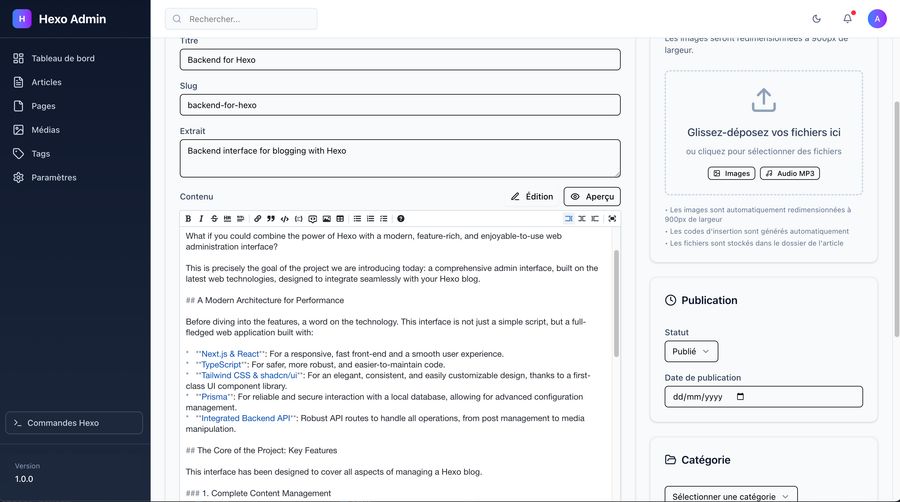Backend for Hexo

Discover the New Admin Interface for Your Hexo Blog: Modern, Fast, and Feature-Rich
Hexo is an incredibly powerful and fast static site generator, beloved by thousands of developers and bloggers for its simplicity and performance. However, content management has traditionally been handled through the command line and text editors, which can sometimes lack user-friendliness for daily use.
What if you could combine the power of Hexo with a modern, feature-rich, and enjoyable-to-use web administration interface?
This is precisely the goal of the project we are introducing today: a comprehensive admin interface, built on the latest web technologies, designed to integrate seamlessly with your Hexo blog.
A Modern Architecture for Performance
Before diving into the features, a word on the technology. This interface is not just a simple script, but a full-fledged web application built with:
- Next.js & React: For a responsive, fast front-end and a smooth user experience.
- TypeScript: For safer, more robust, and easier-to-maintain code.
- Tailwind CSS & shadcn/ui: For an elegant, consistent, and easily customizable design, thanks to a first-class UI component library.
- Prisma: For reliable and secure interaction with a local database, allowing for advanced configuration management.
- Integrated Backend API: Robust API routes to handle all operations, from post management to media manipulation.
The Core of the Project: Key Features
This interface has been designed to cover all aspects of managing a Hexo blog.
1. Complete Content Management
No more switching back and forth between your terminal and your code editor. Manage everything from your browser.
- Posts: Create, edit, and delete your articles through a rich editor. The
src/app/posts/[slug]/edit/page.tsxstructure clearly indicates the presence of a dedicated editing interface for each post. - Pages: Manage your static pages (like “About” or “Contact”) with the same ease as your posts.
- Categories & Tags: Organize your content effortlessly with dedicated interfaces for managing taxonomies.
2. A Powerful, Integrated Media Library
Managing images and other media is often a pain point. Here, it becomes a major asset.
- Centralized Upload: Upload your files (images, videos, etc.) directly from the interface. The
media-uploader.tsxcomponent and theapi/media/upload/API are there for this purpose. - Image Conversion: One of the most impressive features is the presence of dedicated API routes (
convert-to-jpg,convert) that suggest on-the-fly image format conversion to optimize weight and compatibility. - Media Gallery: View and manage all your media from a single page (
src/app/media/page.tsx).
3. Simplified Configuration and Maintenance
- Dashboard: Get an overview of your site as soon as you log in.
- Site Settings: Modify your Hexo blog’s configuration directly from the interface via the
api/config/route. - Health Check: An
api/health/route is available, allowing you to quickly verify that the application and its services are running correctly. - Analytics: A dedicated page (
src/app/analytics/page.tsx) is present, suggesting the ability to view your site’s statistics directly in the admin panel.
4. Deep Integration with Hexo
The goal is not to replace Hexo, but to enhance it. The api/hexo/route.ts API route is likely the heart of this integration. We can imagine it allows triggering essential Hexo commands like:
-
hexo generateto build the static site. -
hexo deployto deploy it. -
hexo cleanto clear the cache.
5. Real-Time Communication
The presence of a src/lib/socket.ts file and a WebSocket usage example (examples/websocket/page.tsx) is particularly exciting. This opens the door to real-time features such as:
- Instant notifications (e.g., “Deployment finished!”).
- A live preview of posts as you write them.
- Real-time display of site generation logs.
How to Get Started?
Although the project is still under development, its structure gives us an idea of the steps to install it:
- Clone the project: Get the source code from the Git repository.
- Install dependencies:
npm installoryarn install. - Configuration: Create a
.envfile to connect the interface to your Hexo blog folder and configure the Prisma database settings. - Launch:
npm run devto start the development server. - Access: Open your browser to
http://localhost:3000and start managing your blog!
Conclusion
This admin interface for Hexo is much more than a simple tool: it’s a true game-changer for users of the platform. By combining a modern user experience, powerful features, and a solid technical architecture, it promises to make content management faster, more intuitive, and simply more enjoyable.
It is the perfect companion for anyone who loves the performance of their Hexo static site but has been dreaming of a worthy admin interface. This project is definitely one to watch.